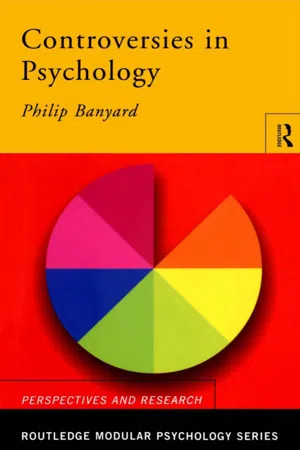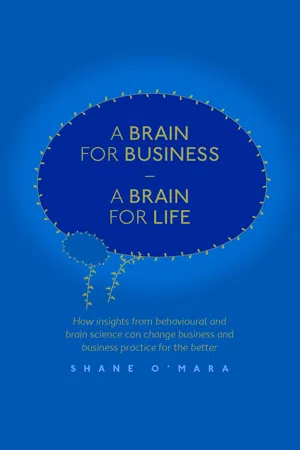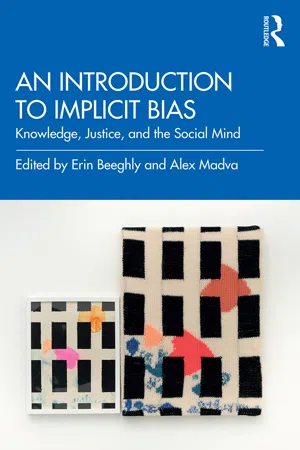Biases
Biases refer to systematic patterns of deviation from rationality or objectivity in judgment. These deviations can occur in various forms, such as cognitive biases, which are errors in thinking, or social biases, which involve prejudices and stereotypes. Biases can influence decision-making, perception, and behavior, often leading to inaccurate or unfair outcomes. Understanding biases is crucial in psychology for addressing their impact on individuals and society.
8 Key excerpts on "Biases"
- eBook - ePub
- Phil Banyard(Author)
- 2003(Publication Date)
- Routledge(Publisher)
...4 Bias in psychology Introduction It is interesting that we have a title such as ‘bias in psychology’. It seems obvious to me that everything in psychology contains some sort of bias or other, but what is remarkable is that this bias is often not acknowledged. Perhaps this is because one feature of the scientific approach in psychology is the attempt to be objective. To be objective is usually taken to mean standing apart from the subject that is being studied, and being free from bias. This might be possible if we are studying chemicals or micro-organisms, but is it possible to be objective when we are studying the behaviour and experience of people? It is difficult, if not impossible, to stand apart from the subject that is being studied when the subject is human behaviour and experience and you are a human being. In this chapter we will look at some examples of bias in psychology, and pay particular attention to issues around cultural diversity and gender. We will start by looking at the concept of ethnocentrism. Ethnocentrism One source of bias in psychology comes from the fact that we tend to see things from our own viewpoint and the viewpoint of people like us. In our everyday lives we are asked to make judgments about people and events. We have a range of opinions that we are prepared to offer to other people when asked, and sometimes when not asked. In our judgments we are often inclined to show a little egocentrism (seeing things from our own particular viewpoint to the exclusion of others)...
- eBook - ePub
A Brain for Business – A Brain for Life
How insights from behavioural and brain science can change business and business practice for the better
- Shane O'Mara(Author)
- 2017(Publication Date)
- Palgrave Macmillan(Publisher)
...Biases in decision-making may serve to reinforce affiliation or strength of the bonds within a tightly defined group, for example. Biases may also serve to punish behaviour that is seen to be transgressive—taking too much reward for too little effort (free-loading), for instance. In this case, there may even be a willingness to engage in costly punishment— to punish a member of one’s own group, or to punish an opposing group, even if there is an economic cost to oneself and to one’s group (Heinrich and colleagues 2006). The question posed by the group is simple: ‘what sort of a hit are we willing to take in order to teach the other lot a lesson?’ Both history and experiments show that humans are willing to take punishments in order to teach the other side a lesson—costly punishments that would not be prescribed by a purely rational calculus. The other side in the dispute may assume that there will be no costly punishment, as in believing that ‘they won’t impose trade sanctions on us. After all, they sell us a lot of cheese (or cars, or wine, or shoes—or whatever)’. But they can, and they will. A refusal to recognise in a negotiation that one side will act contrary to their own narrowly defined economic self-interest to ensure a broader political, legal and social lesson is learned is a very common mistake. Cognitive Biases are a pervasive and universal aspect of human thinking. In essence, they are systematic Biases in gathering information and in thinking that lead to a deviation from rationality calculations or even simply what is demonstrably ‘good and fair judgement’. The case study in the Chapter 1 of this book provides many examples of many cognitive Biases, and we will discuss a few them below. There are huge numbers of Biases—the Wikipedia entry for ‘ Cognitive Bias ’ lists more than 175 of them...
- eBook - ePub
- (Author)
- 2020(Publication Date)
- Wiley(Publisher)
...However, their apparent differences from the average population are sometimes interpreted to be inferior or abnormal. Here bias takes the form of interpretation. Data do not speak for themselves, or in other words, any evidence must be interpreted in order to make sense. This is why in empirical research papers the result section is followed by a discussion section, which sheds light on what the data mean. And when interpreting data, researchers might introduce stereotypes or preconceived notions and arrive at biased conclusions. Ignorance of the possibility of biased interpretation can contribute to a naïve notion of evidence‐based practice, because rather than directly determine practical intervention, evidence must be interpreted first. For example, symptoms of maladaptation do not necessarily suggest maladaptive personality traits to be treated; the problem can be possibly caused by social environment or relationship. One very well‐known bias is confirmation bias, which refers to the researcher’s tendency of looking for and interpreting information in a way that confirms his/her existing expectations or beliefs (Nickerson, 1998). For example, with the expectation that one participant has certain personality traits, a researcher can make selective observation and interpretation of that participant’s behavior to confirm his/her expectation. Another common cognitive bias is the fundamental attribution error. According to this notion, people tend to explain human behaviors in terms of the internal characteristics of the actor, such as personality, instead of social contexts or situations. The fundamental attribution error signifies a dividing line between personality psychology and social psychology, namely whether we attribute participants’ behavior to their personality or to their social context. Researcher bias should be distinguished from Biases caused by participants, theory, method, or language...
- eBook - ePub
Why We Do What We Do
Understanding Our Brain to Get the Best Out of Ourselves and Others
- Helena Boschi(Author)
- 2020(Publication Date)
- Wiley(Publisher)
...chapter seven Our Brain and Biases ‘There is no neutrality. There is only greater or lesser awareness of one's bias.’ PHYLLIS ROSE Literary critic, essayist, biographer and educator (1942–) ABOUT THIS CHAPTER Being biased is a human phenomenon. We are all biased and we use our Biases every day, often unconsciously, to help us make decisions. Biases are the beliefs, attitudes and preferences that we form about ourselves and other people. We pick up these Biases through our culture, background and education and they are pervasive influences over how we see the world and make decisions. Our brain has to predict rapidly what is safe or harmful in our environment. To help our brain do this, our Biases quickly shortcut new information. The problem is that they intervene so quickly that we may make a bad choice or overlook a crucial detail. This chapter explains how Biases work in our brain and shows how our Biases may distort our thinking or prevent us from forming an accurate view of the world. Part 1: The science explained A psychological immune system in the brain Our Biases are human adaptive responses to our environment and provide an immediate frame of reference for fast interpretation and action. In a sense, our Biases are our brain's psychological immune system and prevent us from decision paralysis. 1 If we were unable to respond quickly to our surroundings we would not have been able to survive as a species. FIGURE 7.1 : We are all biased Why are our Biases so powerful? Our Biases (Figure 7.1) play a more powerful role in our decision-making than many of us realise, particularly when we have limited information or when we are in a heightened emotional state...
- eBook - ePub
An Introduction to Implicit Bias
Knowledge, Justice, and the Social Mind
- Erin Beeghly, Alex Madva, Erin Beeghly, Alex Madva(Authors)
- 2020(Publication Date)
- Routledge(Publisher)
...One of the great criticisms of behaviorism, however, is that it cannot account for mental interaction, that is, effects that are the joint result of many mental causes. So, try to think about implicit bias in the context of a complete psychology that has perceptions, inferences, actions, desires, problem-solving abilities, is embodied, etc. (see Leboeuf, Chapter 2, “The Embodied Biased Mind,” and Greene, Chapter 7, “Stereotype Threat, Identity, and the Disruption of Habit”). How might our understanding of implicit bias and its construct change when we think about it in this domain? Psychologists Amos Tversky and Daniel Kahneman are famous for work demonstrating that the human mind is prone to adopt a wide-variety of shortcuts and heuristics (see Beeghly, Chapter 4, “Bias and Knowledge: Two Metaphors” for more on the view of Biases as “shortcuts”). They argue that the mind is composed of two distinct “systems”: system one involves the many mental shortcuts and is responsible for our fast, automatic behaviors while system two involves more rational processes and is responsible for our slow, deliberate behaviors. How does this picture fit with the theories of implicit Biases that we’ve been discussing? What implications might this have for the existence of other implicit constructs outside of the social domain? How might this change the way we theorize about the psychology of bias? REFERENCES Axt, J.R., Ebersole, C.R., and Nosek B.A. (2014) The rules of implicit evaluation by race, religion, and age. Psychological Science, 25(9): 1804–1815. Banaji, M.R. and Greenwald, A.G. (2013) Blindspot: Hidden Biases of Good People. New York: Delacorte Press. Banaji, M.R. and Hardin, C.D. (1996) Automatic stereotyping. Psychological Science, 7(3):136–141. Bar-Anan, Y., Nosek, B.A., and Vianello, M. (2009) The Sorting Paired Features Task: A measure of association strengths. Experimental Psychology, 56(5): 329–343. Brinol, P., Petty, R., and McCaslin, M...
- eBook - ePub
Cross-Cultural Psychology
Critical Thinking and Contemporary Applications, Sixth Edition
- Eric B. Shiraev, David A. Levy(Authors)
- 2016(Publication Date)
- Routledge(Publisher)
...One final point deserves mention. Can you determine which of these responses reflects the “real” you? Notice that this question is, in itself, virtually unanswerable without also taking into account the context of the situation. What is responsible for this attributional error? Social psychologists have identified two principal sources: cognitive Biases and motivational Biases. Cognitive Biases refer to systematic mistakes that derive from limits that are inherent in our capacity to process information. Because we are not capable of perceiving everything in our environment, our focus is automatically drawn to the most prominent or “eye-catching”—that is, perceptually salient—stimuli. This can lead us to formulate biased and inaccurate causal attributions (Taylor & Fiske, 1975). Specifically, we are prone to equate the most perceptually salient stimuli with the most causally influential stimuli. In contrast, motivational Biases refer to systematic mistakes that derive from our efforts to satisfy our own personal needs, such as the desire for self-esteem, power, or control. Simply put, motivational Biases serve the function of making us feel better, even if they do so at the expense of distorting, obscuring, or falsifying reality. Are we motivated to prefer one type of causal attribution over another? It would appear so. In the case of Western cultures in particular, we are told from early childhood to believe that people can control their destiny and are the masters of their fate. As such, society generally condones dispositional attributions, while it discourages situational attributions. In this way, we can fool ourselves into overestimating the degree of control that we actually do have, while underestimating the impact of external factors that lie beyond our control...
- eBook - ePub
Building an Outstanding Workforce
Developing People to Drive Individual and Organizational Success
- Paul Aldrich, Andrew Pullman(Authors)
- 2019(Publication Date)
- Kogan Page(Publisher)
...Some appear to be due to human evolution and others learnt from individual experience. They impact decision-making and social interaction. Neuroscience f or Leadership explains that heuristics are experience-based processes for solving problems, often relying on trial and error. The term has been used in psychology for unconscious, instinctive or learned processes which are quick and tend to work in most cases but can lead to mistakes. Systematic errors are known as Biases. Fallacies are mistakes in reasoning or belief, which may, in some cases, also be due to Biases or heuristics. 3 People Risk Management lists some common cognitive bias: overconfidence: overestimating positive outcomes; loss aversion: weighing losses greater than gains; groupthink: conforming to group beliefs; anchoring bias: relying to heavily on one piece of information; confirmation bias: searching for information to support existing beliefs; illusion of control: overestimating one’s control over events; planning fallacy: underestimating execution problem; sunk-cost fallacy: sticking with decisions because of the cost already expended; availability bias: giving precedence to recently available information; attentional bias: focusing on prevalent and/or recurrent thoughts; ambiguity bias: dismiss alternatives if little or no information is available; action bias: tendency for action over inaction; halo effect: assigning confidence based on past success; illusion of skill: attributing poor outcomes to luck rather than lack of ability; status quo bias: wanting things to stay the same. 4 Heuristics can be described as rules-of-thumb or educated. guesses...
- eBook - ePub
Taking Sides in Social Research
Essays on Partisanship and Bias
- Martyn Hammersley(Author)
- 2005(Publication Date)
- Routledge(Publisher)
...6 Bias in social research With Roger Gomm Accusations of bias are a recurrent event in the social and psychological sciences. Some of these have achieved the status of major public events, such as the attacks on hereditarian theories of intelligence, notably on the work of Cyril Burt (Kamin 1977; see also Mackintosh 1995); the response to the Glasgow University Media Group's books on television news (see Harrison 1985); and Derek Freeman's critique of Margaret Mead's Coming of Age in Samoa (Freeman 1983). And of course, in many cases, the reaction to an accusation of bias is a counter-charge, indicating that it is not just research itself but also evaluations of research that can be biased. 1 However, despite the frequency with which it is used, the meaning of the term ‘bias’ has been given rather little attention in the methodological literature. And it is by no means unproblematic. For one thing, the term is ambiguous: it is used in several different ways. We will begin by outlining what seem to be its three main senses. In the Preface to his book on the intellectual Left in post-war France, Sunil Khilnani announces that it is ‘quite explicitly and in the original sense a biased book: it proposes a new angle of vision, one which brings certain significant patterns into clearer focus’ (Khilnani 1993:vii). It should be said that the Oxford English Dictionary does not offer any evidence that this is the original meaning of the word; in fact, it does not mention this sense at all. Nevertheless, the idea that point of view can make a difference to how well one discerns significant patterns in a scene, or in a sequence of events, is a common-sense one. And it has been developed in a methodological context by Max Weber, in the form of his theory of ideal types. Weber defines an ideal type as: ‘a conceptual pattern that brings together certain relationships and events of historical life into a complex that is conceived of as an internally consistent system’...







